|
Apparate & Kamerabau Gmbh (AkA, after 1957 akw ) was based in Friedrichshafen, Germany, and was founded just after WWII by brothers Eugene and Max Armbruster. Their first camera was the Akarette, a camera with interchangable lens mount and automatic cocking of the shutter during film transport, an impressive start! It was followed by the Akarex, a rangefinder camera which included a version with an interchangeable lens mount. The rangefinder and lens were changed as a single unit, which was a rather unique concept. After this came the Arette series, a long-lived range of cameras from simple viewfinders to rangefinders with light meters and eventually semiautomatic exposure. Some had interchangeable lenses with the same lens mount as the early Akarette cameras. In the end, however, the brand lost its edge and stopped making cameras around 1960.
The Akarette, later renamed to Akarelle, was the first range of cameras by AkA and was introduced in 1947.
Akarette I
The Akarette I was developed just after WWII and featured an interchangeable lens mount as well as a shutter that was cocked automatically when winding the film. These were rather advanced features at the time, otherwise only found on the like of e.g., Leica and Contax. The first version had a 24x32 mm film frame for 40 exposures on standard 135 film, later versions had regular 24x36 mm film frames (or so goes the story... see first photo for an early example that doesn't conform to this). It had two viewfinders, one for standard lenses and one for 7.5 cm telelenses, either a f/3.8 Tele-Xenar or a f/4.5 Radionar. A little switch on the front would mask one of the viewfinders. The body was covered with black enamel with a grey-coloured front plate.
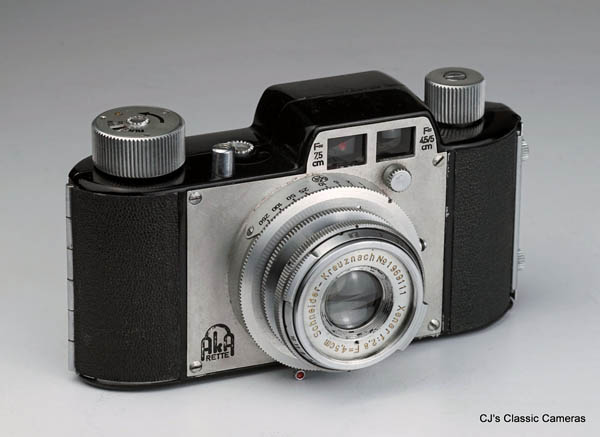
The first batch of Akarette I had no cold shoe on top. This probbaly explains why on the later model the shoe looks a bit like an afterthought. An example is shown here with an early version of Schneider-Kreuznach Xenar 45mm f/2.8 lens, quite distinct from the later versions found further down this page. Surprisingly, it is the standard 24x36 mm format and has a the frame counter counts up to 35. The serial number (hidden behind the depth of focus table at the back) is 175. This calls into question some of the history of this model as presented on the internet, unless only a very small amount of cameras with reduced film frame size were produced. This example is not mine by the way, I repaired it for a fellow collector from the USA.
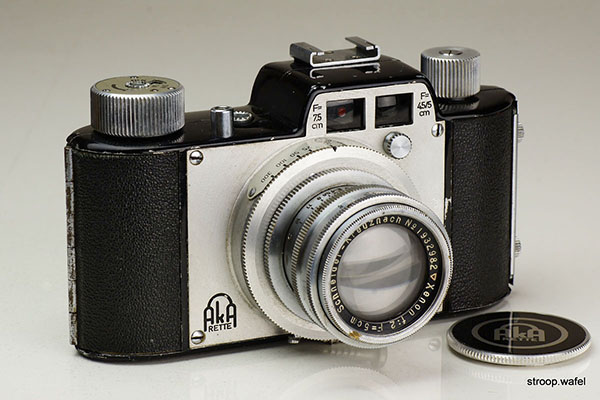
A somewhat later Akarette I with a Schneider-Kreuznach Xenon 50mm f/2 lens. This one is a hybrid model, it is the standard 24x36 mm format but the frame counter counts up to 40 as in the early 24x32 mm model. The serial number is 932.
It was in good cosmetic condition but otherwise a disaster: shutter stuck, time delay stuck, lens focus stuck and lens glass completely fogged up due to front element separation. Luckily Akarettes are easy to take apart and other than the lens it is now back in working order. The lens serial# indicates a production date around winter 1947/48, which matches the age of the camera.
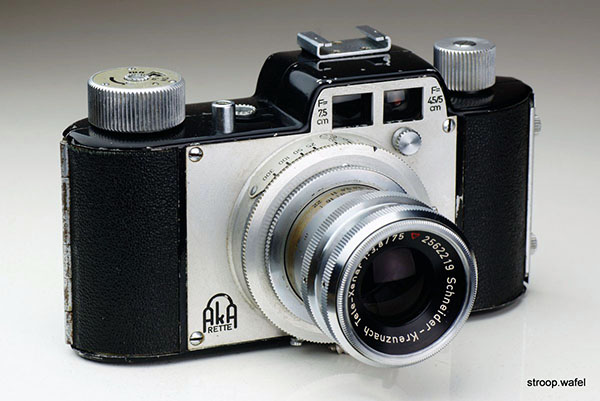
The same camera but here with Schneider-Kreuznach Tele-Xenar 75mm f/3.8 lens. The bottom part of the lens suffered from significant brassing, probably due to the mounting ring rattling against it when the lens was not in use.
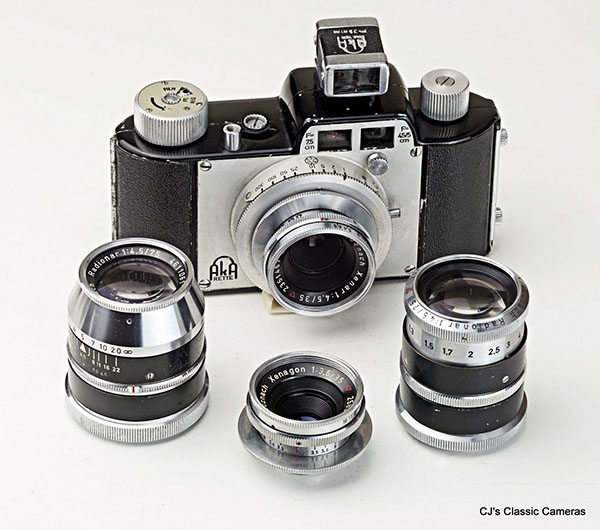
A remarkably large range of lenses was available for the Akerette/Akarelle range, and I keep finding lenses that I have haven't seen before. Two of them are shown here and compared with two similar lenses I already owned. One is a wide angle 35mm f/4.5 Schneider Xenar lens, very similar in many aspects to the slightly faster 35mm f/3.5 Schneider Xenagon. Xenars with a 35mm focal length are very unusual, the closest I've seen are the 38mm Xenars found on Robot cameras, but those are 24mm square format, so 38mm is in fact their 'standard' lens. As the Akarette did not have a 35mm viewfinder window (45 and 74 mm only), a separate viewfinder was available, which you can see mounted on top of the camera here.
The other lens is a Schneider 75mm f/4.5 Radionar, which appears to be different to the more commonly encountered version I already have (shown on the right) in shape only. It was produced about 4 years later (in 1956) and this is a little suprising considering that by then the Akarelle was produced with 90mm frame lines as standard.
Akarette 0
A cheaper version of the Akarette I was the Akarette 0, which had a black front plate, lacked the viewfinder switch, had a simpler Vario or Prontor shutter instead of the standard Prontor-SV shutter, and came with a Radionar lens instead of the Xenar or Xenon lens on the Akarette I. It also lacked the film reminder dial integrated in the wind knob. The body had no covering material. Ironically, because of the use of materials these cameras have stood the test of time in general much better than the other Akarette versions and are usually found in excellent cosmetic condition.
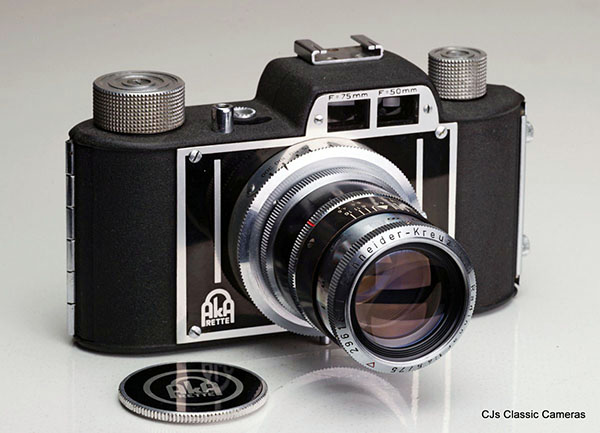
An Akarette 0 with Schneider Radionar 75 mm f/4.5 lens, which complemented the Radionar 50mm f3.5 standard lens, and was the telelens for this model instead of the Tele-Xenar for the Akarette I above. Telelenses designated as Radionar were pretty unusual, in fact this is the only one I know of. It is a triplet, just like the Radionar standard lens, and it is front-cell focussing, whereas the Tele-Xenar is helical focussing.
Akarette II
The Akarette II was introduced in 1950 and had metal top and bottom plates, but was otherwise very similar to the Akarette I. The main differences were the addition of strap lugs, an accessory shoe and a small lever instead of a knob to change between viewfinders.
Several small changes were made during the lifetime of this model. The groove pattern of the wind and rewind knobs changed and the strap lugs changed position. Early production still had a depth of field scale on the back of the camera. The shutter speed markings around the lens base also went through several small changes, whereas only later examples had the shutter name Prontor-SVS printed on the lens mount. Some early examples apparently had frame counters up to 40 exposures, similar to the Akarette I. On later examples the frame counter would only go up to 36, but had a big gap between '36' and '0', so most likely the frame counter mechanism was still the same. Later production again had regular 36 frame counters.
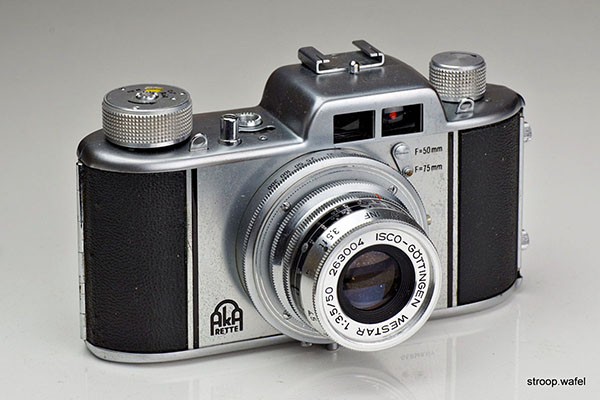
An Akarette II with Isco Westar 50mm f/3.5 lens. This is a late version with strap lugs mounted at the front of the top housing.
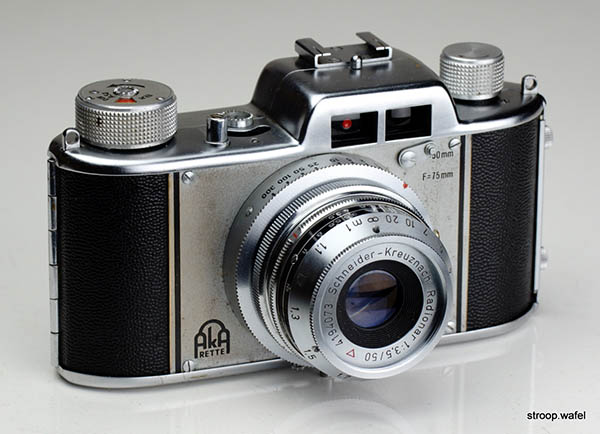
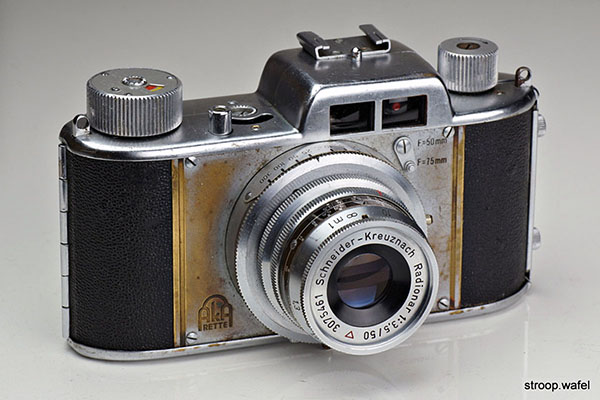
Two more Akarette II. The one the left is a later model but earlier than the one above, with strap lugs mounted on the far end of the top housing and a different lens mount. The one on the right is an early version with yet again a different lens mount and a rewind knob with a screw in the middle. Note the wear to the chrome on the front plate, unfortunately very common for the Akarette/Akarelle models as it was very thin. Take extreme care if you get one of these and want to clean the front plate.
Akarelle
The Akarelle was developed from the Akarette II but featured a wind lever instead of a wind knob. Early production still had a switch between viewfinders for 50 and 75mm lenses, later versions had a bright frame viewfinder with frame lines for 50mm and 90mm lenses. Note the change in viewfinder from 75mm to 90mm for the telelens, the matching lens being the 90mm f/3.5 Tele-Xenar. Other changes during production included the shutter, a Prontor-SVS on later examples, and the rewind knob with integrated film speed indicator.
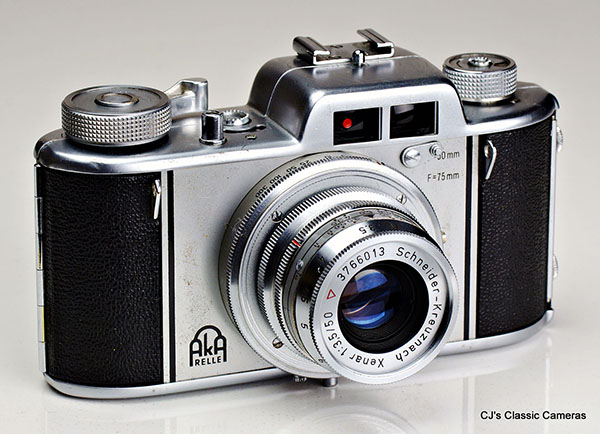
Early Akarelle with Schneider Xenar 50mm f/3.5 lens. Note the viewfinder switch, which it inherited from the Akarette but was to be replaced by a bright-frame viewfinder on later production.
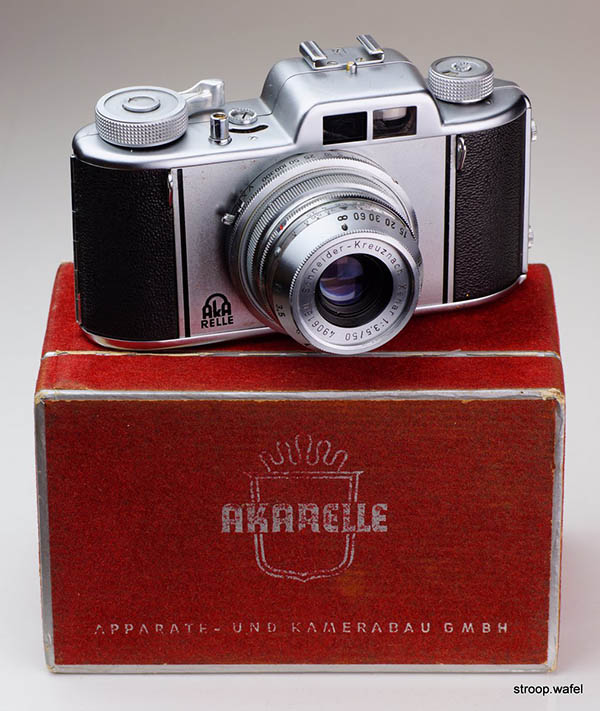
Late Akarelle with Schneider Xenar 50mm f/3.5 lens and its original box. It also came with its original receipt, it was originally sold in 1958 for �32 10".
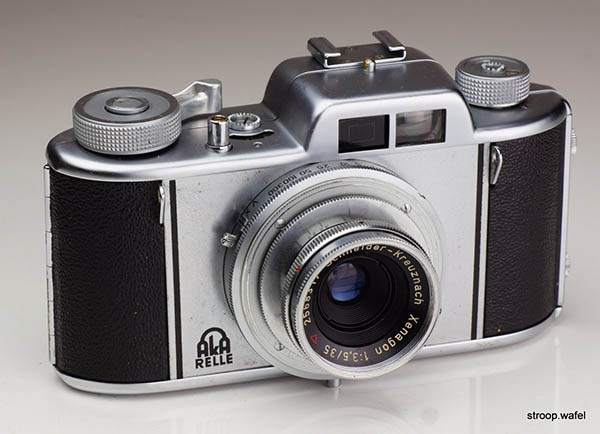
The same Akarelle with the tiny Schneider-Kreuznach Xenagon 35mm f/3.5 wide-angle lens. None of the Akarette models had a 35mm viewfinder, thus a separate viewfinder would have been required to use this lens, but the Akarelle viewfinder covered the 35mm field of view.
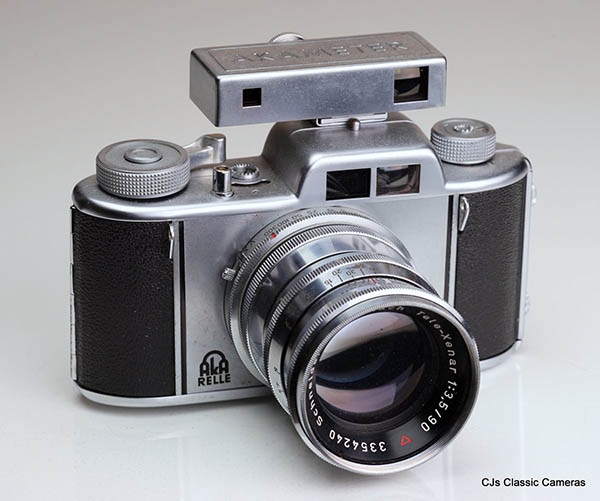
Akarelle with Schneider-Kreuznach Tele-Xenar 90mm f/3.5 telelens and Akameter rangefinder accessory. No Akarette/Akarelle cameras had a rangefinder, so this accessory was very useful. It was made in the same style as the rangefinder found on the Akarex III (see below).
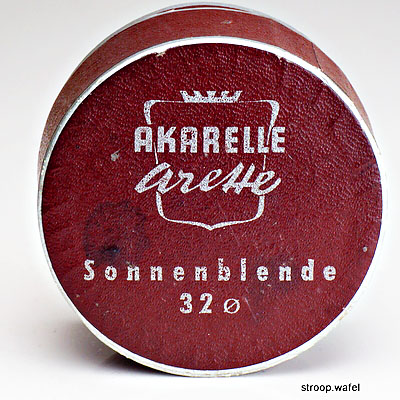
|
A collapsible rubber lens shade dedicated to the Akarelle and later Arette range came in this cute little storage container.
|
Akarex I
The Akarex was introduced in 1953 and came in two versions, the Akarex I with fixed lens and the Akarex III with interchangeable lens mount. Not sure what the Akarex II was supposed to be, but I don't think it ever saw the light of day. The styling of the Akarex was quite a change from the Akarelle and more similar to the later Arette IA and IB (see below). The Akarex I had an uncoupled rangefinder with a dial at the rear of the top housing which was a little awkward to handle, as it was positioned very close to the eye piece. It was a nice camera, but rather unremarkable compared to its better featured cousin, the Akarex III featured below.
The Akarex I came in at least two slightly different versions. Early production had a smaller rewind knob with rounded top and a similarly styled wind lever, whereas later production, as in the sample below, had flat knobs and lever with a metal ridge.
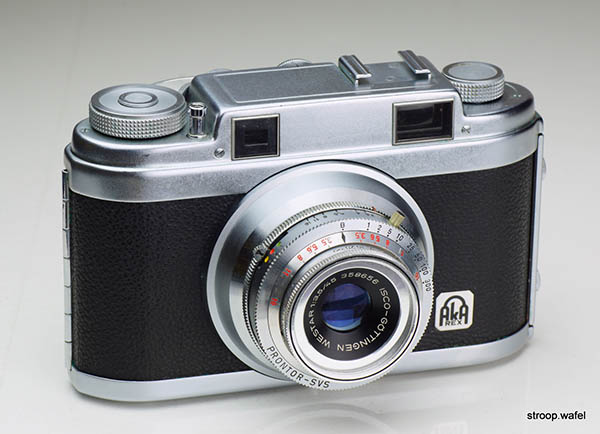
Late version of the Akarex I with Isco Westar 45mm f/3.5 lens in Prontor-SVS shutter. The metal work of these is very prone to brassing, but this one is very nice indeed.
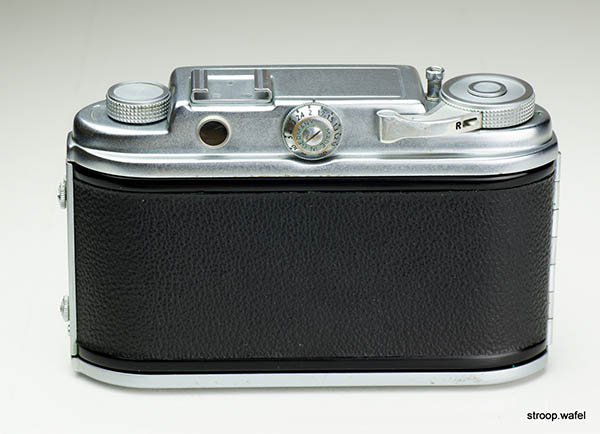
Rear view of a late Akarex I showing the uncoupled rangefinder focus dial.
Akarex III
The Akarex III was Aka's first coupled rangefinder camera. In addition it had an interchangeable lens mount. The Akarex III was in fact a truly unique camera, as lens and coupled rangefinder were interchangeable as a single unit. This avoided the need for separate viewfinder and rangefinder as found on most other interchangeable lens cameras from that time. Unfortunately the lens-rangefinder units were rather large, which did not help the portability of the system. The lenses were from Schneider Kreuznach, available focal lengths were 35mm, 50mm and 90mm, the 50mm available with f/3.5 (Xenar) or f/2 (Xenon) aperture. Apparently a cheaper Westar 45mm f/3.5 was also available, but I have never seen one. Some changes were made to the camera body and the rangefinder units during their production, these are detailed below. It appears all Akarex III were equipped with a Synchro-Compur shutter.
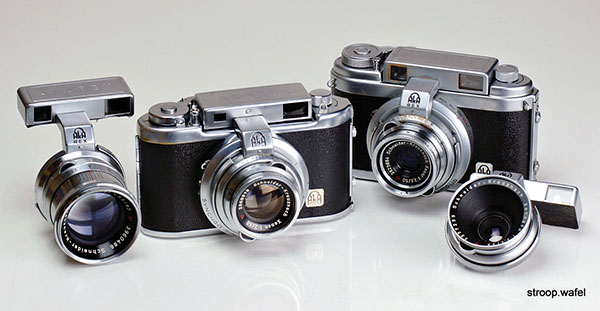
The Akarex III family: two Akarex III versions both with Synchro-Compur shutter and their interchangeable lens-rangefinder units. From left to right a Tele-Xenar 90mm f/3.5, an early Akarex III with Xenon 50mm f/2, a late Akarex III with Xenar 50mm f/3.5 and a Xenagon 35mm f/3.5, all lenses by Schneider.
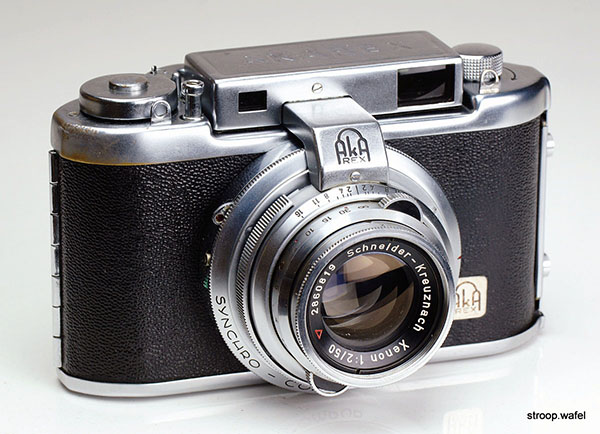
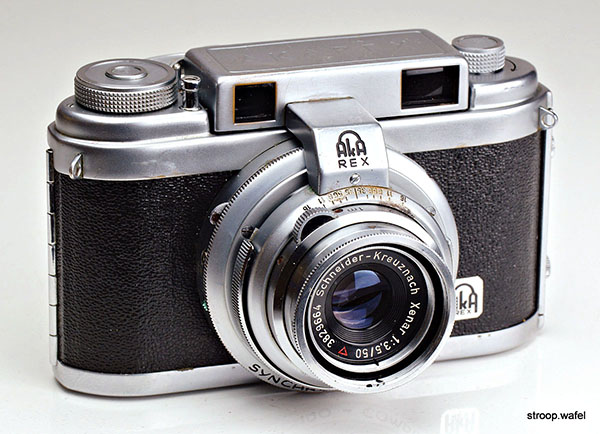
(left) Early version of the Akarex III with matching Xenon lens, (right) Late Akarex III with matching Xenar lens. Note the differences between the cameras: the style of the rewind knob and wind lever, the position of strap lugs and the shape of the top housing, which has an extra ridge on the late version.
The rangefinder units of the interchangeable lenses also changed: the early version had a small rangefinder window and a screw in the front centre. The Akarex logos were also slightly different.
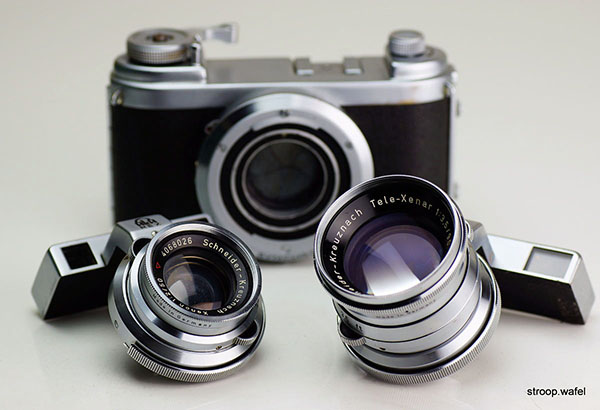
An Akarex III body without a lens mounted. The mount was a bayonet, one had to push the lens onto the camera and then twist a ring on the lens which would secure it. Also note the accessory shoe in the middle of the body, which is normally hidden under the rangefinder unit. I've long been pondering about its function, even trying to mount lenses upside down (which does not work), until I saw an adapter that mounted onto the shoe with the rangefinder in place and would slide over the top of the rangefinder unit.
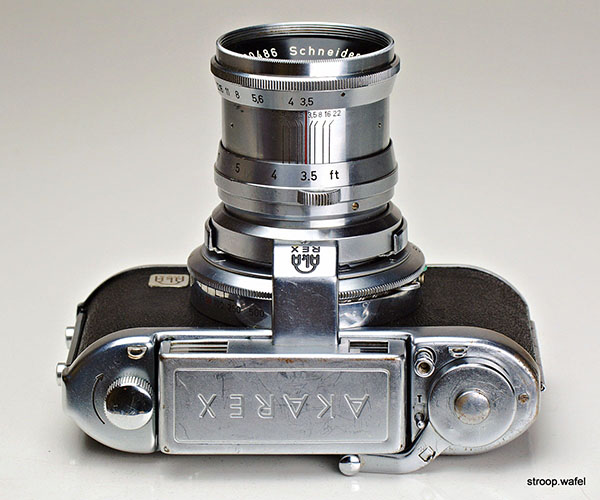
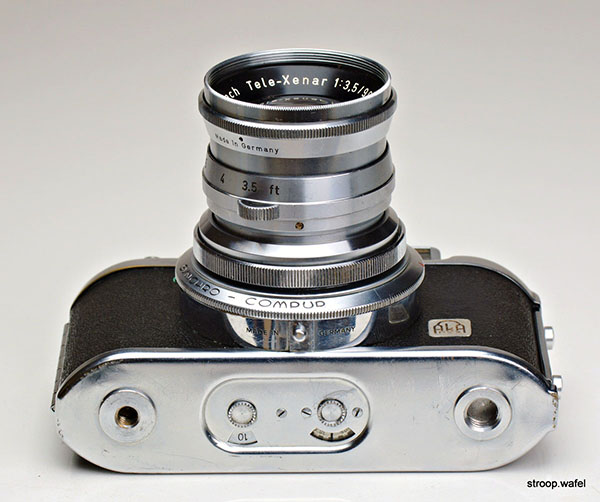
Top and bottom views of an early Akarex III with Schneider 90mm f/3.5 Tele-Xenar mounted. The frame counter and film reminder dials were on the bottom of the camera, which also featured two sizes of tripod mounts.
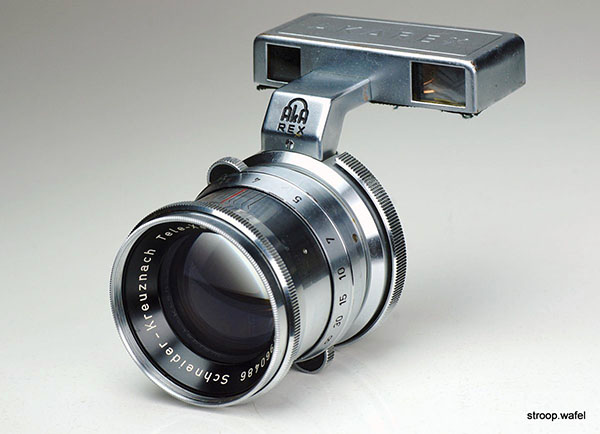
|
One of my favourite lenses, the Schneider 90mm f/3.5 Tele-Xenar lens-rangefinder unit standing by itself. Does it not look like a little space craft?
|
The Arette series was a new range to replace the successful Akarette and Akarelle cameras. The newly constructed body, based on that of the Akarex, had an ergonomically designed curved front plate which allowed a steady grip of the camera. Initially the Arette was a fixed lens viewfinder camera with only two models, the IA and IB.
Arette IA
The Arette IA was the first Arette model, production started in 1956. It was a viewfinder camera with a wind lever on top of the camera which automatically cocked the shutter. The lens was an ISCO Westar or Isconar, the shutter a Pronto or Prontor-SVS. The frame counter and film reminder could both be found on the base of the camera. The shutter release was on the shutter base itself. Export versions were known as the Optina I (with Pronto shutter) or the IA (with Prontor-SVS shutter).
A second version was introduced in 1957 and featured quite a few changes that would also characterise later Arette models. It had the viewfinder on the far left instead of in the middle like the first version, and the wind lever moved to the bottom of the camera. The rewind knob was still in the same location, but was nearly flush with the top housing, it would pop up when pushed down. The name Arette IA was engraved on the front of the top housing instead of on top. The film reminder was where the wind lever used to be. It came with a choice of lenses, such as ISCO Isconar, Schneider Xenar or Roeschlein Arettar.
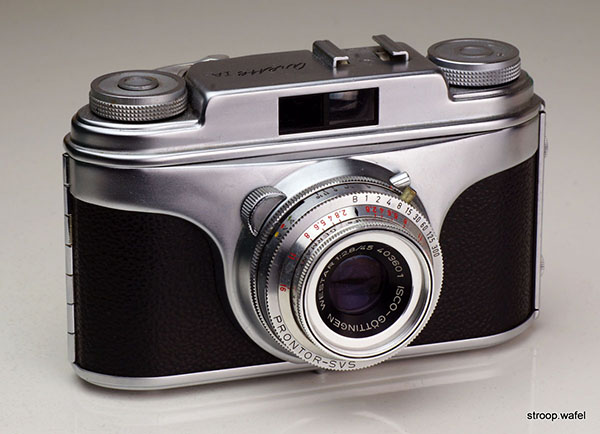
First version of the Arette IA with Isco Westar lens. Personally I prefer this version over the second version below, I like the symmetry of the top housing.
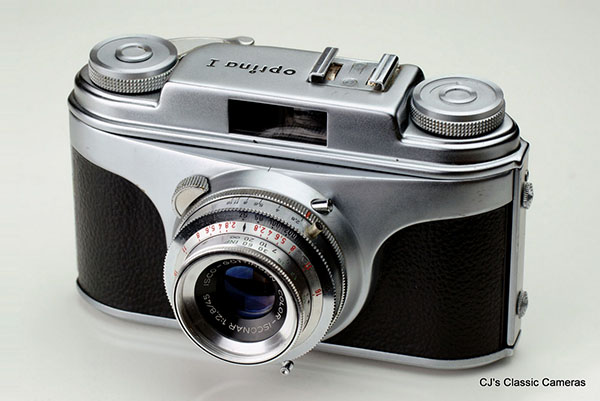
The Arette IA was also available sold as Optina I (with Pronto shutter, shown above) or Optina IA (with Prontor-SVS shutter).
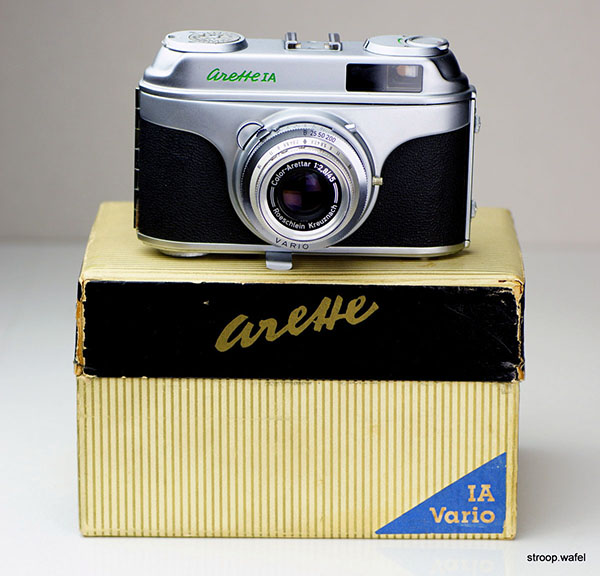
Second, restyled version of the Arette IA with Roeschlein Color-Arettar 45mm f/2.8 lens in Vario shutter, shown here with its original box.
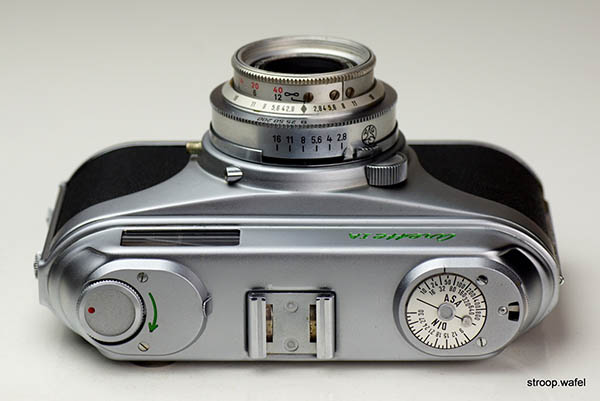
Top view of the same Arette IA showing the pop-up rewind knob and film reminder dial. The top view of the Arette C (see below) was virtually the same.
Arette IB
The Arette IB came out around the same time as the IA. It had an uncoupled light meter integrated in on the right aside of the top housing and therefore the viewfinder had moved to the left side. Early production cameras had a Gossen light meter with a large black and white exposure dial, whereas later cameras had a more modern unit with LV markings. An export version with the old style light meter was known as the Optina IB (see below).
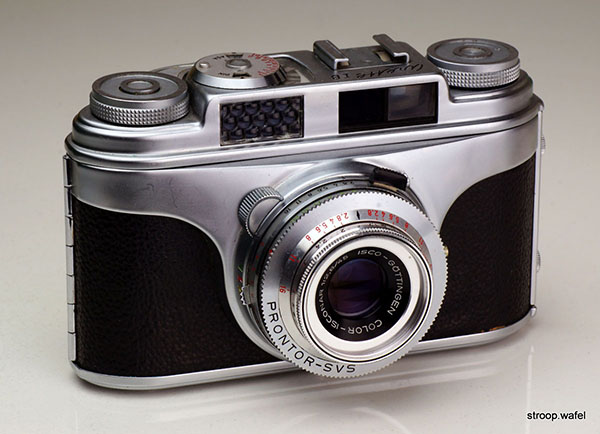
Later version of the Arette IB with LV style light meter.
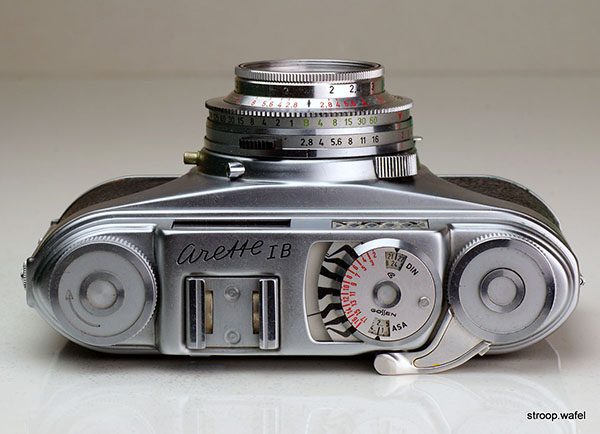
Top view of an Arette IB with working light meter.
Optina IB
Several Arette models were also marketed under the name Optina by Eaton's in Canada. The early version of the IB, with Gossen light meter with large black and white exposure dial, was one of these. Other ones were the early version of the Arette IA (named Optina I with Pronto shutter or IA with Prontor-SVS), the Arette IBN (named Optina IB like this one, but printed in green font at the camera front) and Arette IC and ID (named Optina IC and ID, respectively). Other cameras rebranded as Optina were the Leidolf Lordox 24x36 and the Dacora Subita.
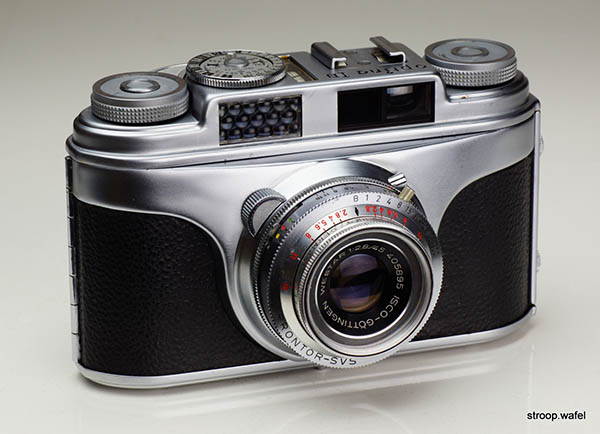
An Optina IB, other than the name identical to the first version Arette IB.
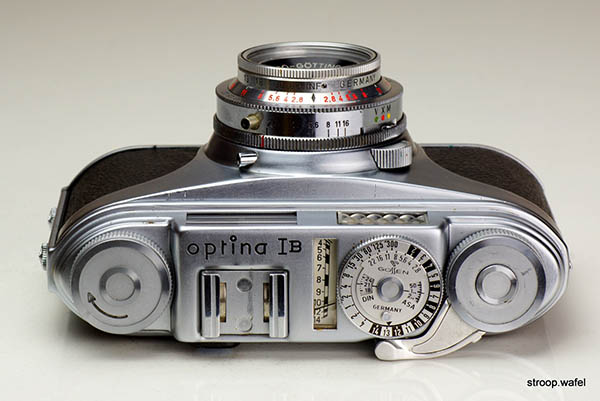
Top view of the Optina IB showing the traditional Gossen light meter that was also used on the first version of the Arette IB. On the later version it was replaced with a unit that only showed LV values (see above).
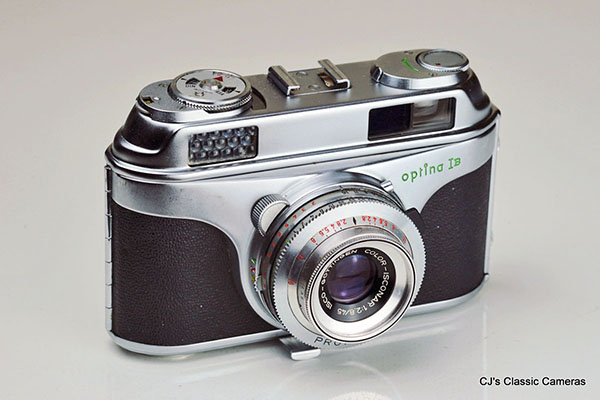
And here is a different Optina IB, a rebranded version of the Arette IBN, which itself predated the Arette BN shown below. It appears to differ in one detail only: the wind knob release lever.
Arette BN
The Arette IB above was superseded by the Arette BN which featured a more modern light meter and a restyled tophousing like the second version of the Arette IA, including an integrated pop-up rewind knob and a film indicator dial next to the lightmeter. This model was for a short while produced as the Arette IBN. An export version was known as Optina IB, the same name as the Optina version of the earlier Arette IB.
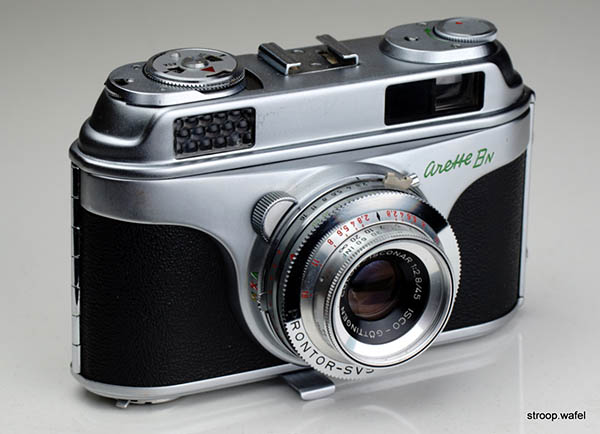
Arette BN with Isco-Gottingen Color-Isconar 45mm f/2.8 lens in Prontor-SVS shutter.
The Arette range was around 1959 updated with larger and brighter viewfinders. It has therefore been necessary to enlarge the top housings, but this did somehow make the cameras lose some of their aesthetic appeal. The Arette Bw and BN above were thus updated, with the lightmeter on the BN rather awkwardly mounted in the middle of the top housing, and new versions were also produced of the Arette A (sold in the UK as Arette P and Arette Super P) with increasingly large viewfinders. In addition, new models were introduced, such as the Automatic S (coupled light meter) and SE/SR (coupled light meter and coupled rangefinder), as well as the Arette W (viewfinder model with interchangeable lens mount). See further below for several of these.
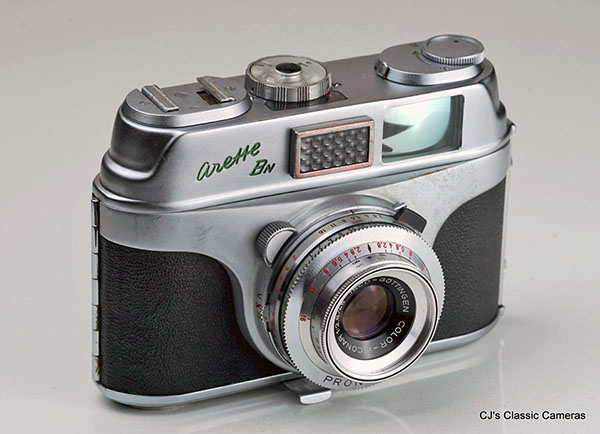
New version of the Arette BN with redesigned body and larger, brighter viewfinder.
Arette IC / C
The 1957 Arette IC had a coupled rangefinder and featured helical focussing with a focus ring at the lens base instead of front cell focussing. Like the later version of the IA, it had the wind lever at the bottom and a pop-up rewind knob. In addition it had a film reminder dial op top. It came with a Color-Isconar or Schneider Xenar lens and Prontor-SVS shutter. Not long after its introduction it was renamed to Arette C, which was a little strange as other models like the IB and ID were renamed to BN and DN. However, the Arette C appears to be literatally the same as the IC, whereas the BN and DNwere different than their predecessors, so presumably the Arette C did not deserve the N (which must have stood for 'neu' or 'new'). This model was also sold as Optina IC.
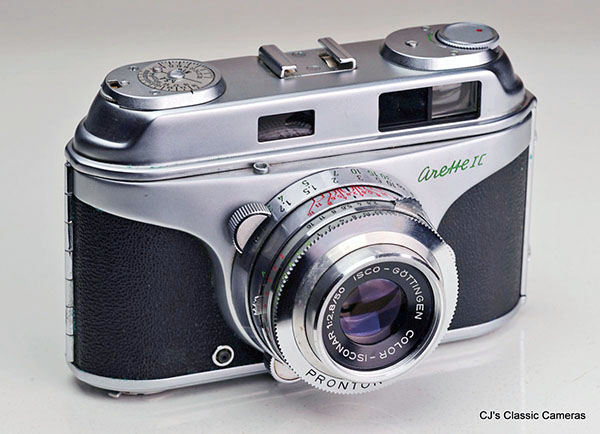
An Arette IC with coupled rangefinder and Isconar 45mm f/2.8 lens in Prontor-SVS shutter.
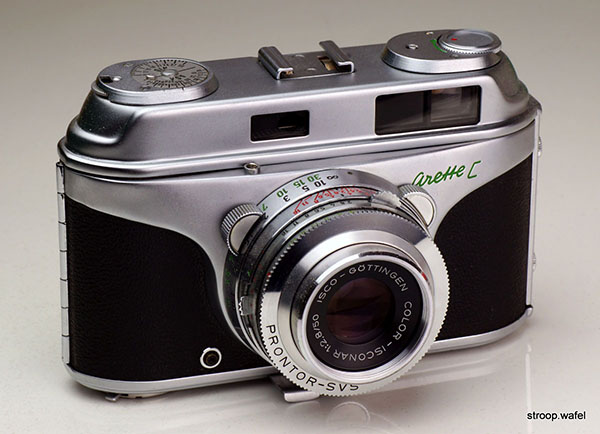
|
And here is the Arette C - spot the differences with the IC above. As far as I can see there were none.
|
Arette ID / IDN / DN
The next step up was the Arette ID, which had a coupled rangefinder as well as a light meter. It had otherwise similar specifications as the Arette IC. Early production had an uncoupled lightmeter similar to the one on the late Arette IB as seen above, whereas later production had a match-needle coupled lightmeter. This later version was later renamed to Arette IDN, then to Arette DN. This model was also produced as Optina ID. All versions where available with Schneider Xenar or Isco Isconar lens in Prontor-SVS shutter.
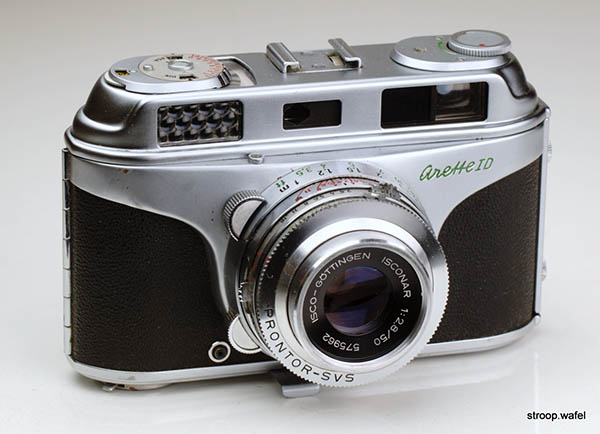
An early example of the Arette ID with Isconar lens and uncoupled lightmeter.
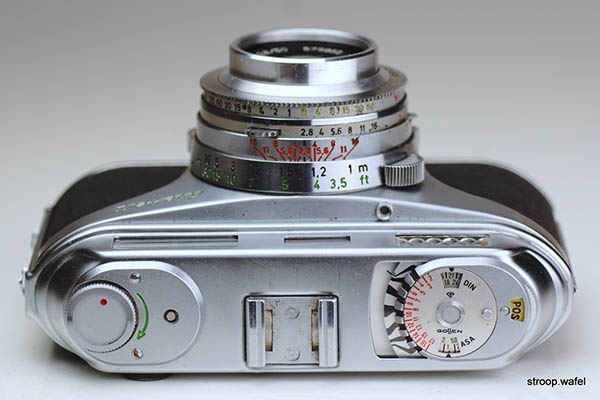
Top view of the Arette ID showing the uncoupled lightmeter.
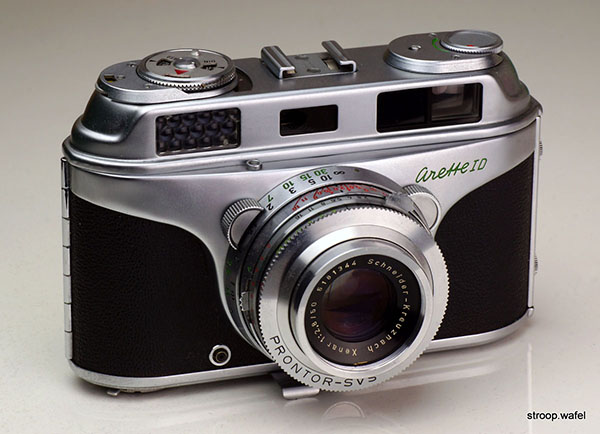
The complete package: a late example of the Arette ID with coupled lightmeter, coupled rangefinder and a Schneider Xenar lens.
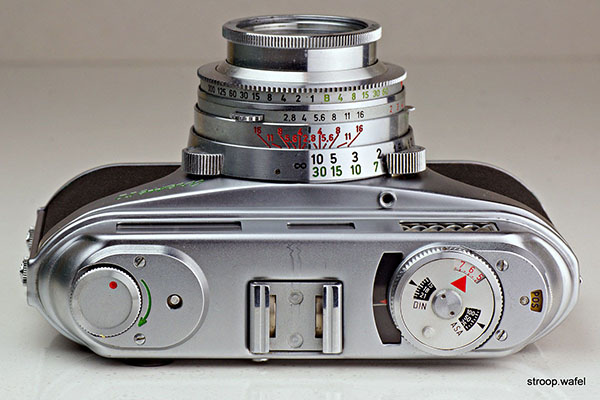
Top view of a late production Arette ID with match-needle style coupled lightmeter.
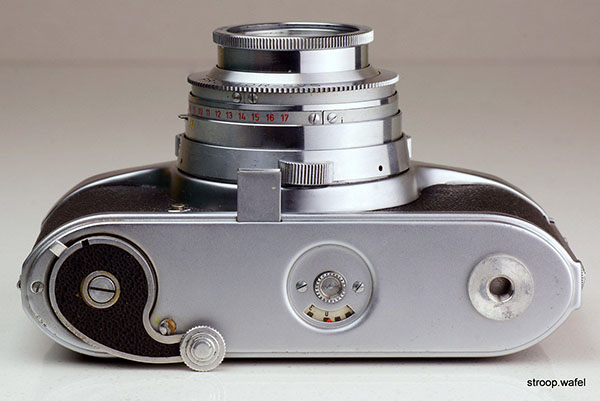
Base of Arette ID showing the frame counter, which is were it can be found on all Arettes. Also note the little pull-out stand beneath the lens mount, ideal for having your camera on display!
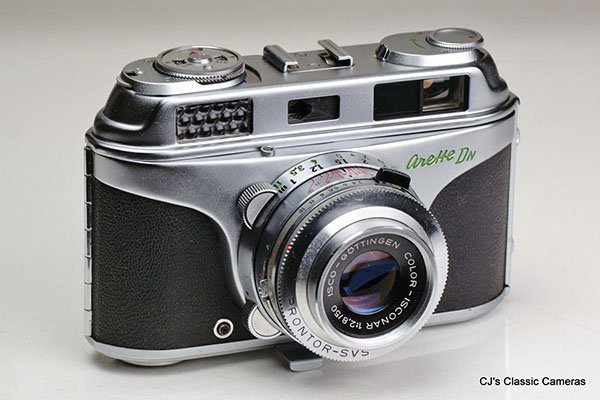
Arette DN with Color-Isconar lens. This model is nearly identical to the late production of the Arette ID, the only difference I could spot was the lever used to pop up the rewind knob. Clearly enough to justify the name change!
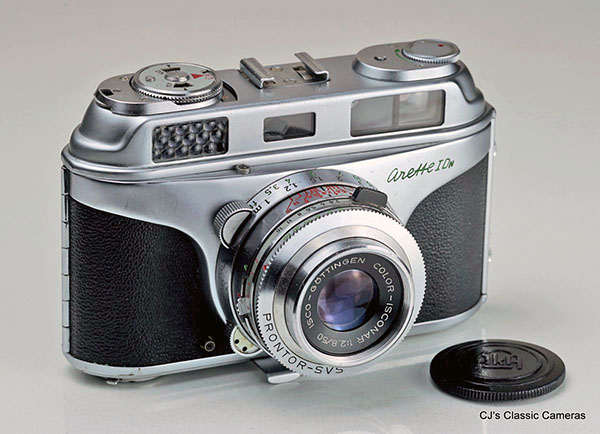
Despite the small changes between Arette ID and Arette DN, there was even an intermediate model named Arette IDN. It was identical to the late version of the ID.
Arette Bw
The 1958 Arette Bw was an Arette B with interchangeable lens mount (w stands for 'Wechselobjektiv', German for interchangeable lens). It had the same lens mount as the earlier Akarette cameras. It was a breech-lock mount with a threaded collar on the lens, similar to the Diax mount but of different dimensions. It featured a light meter but no rangefinder, which is a disadvantage compared to other cameras with interchangeable lens mounts from that era. Presumably it was too complicated to build an interchangeable lens mount with rangefinder coupling. On the positive side, due to the heritage of the Akarette series a selection of good lenses was available.
The light meter was different again, with traditional shutter speed and aperture indicators instead of LV values. This was a logical consequence of the interchangeable lens mount: as the shutter speed ring was on the camera body but the aperture ring on the lens, it was impossible to get LV coupling of the two.
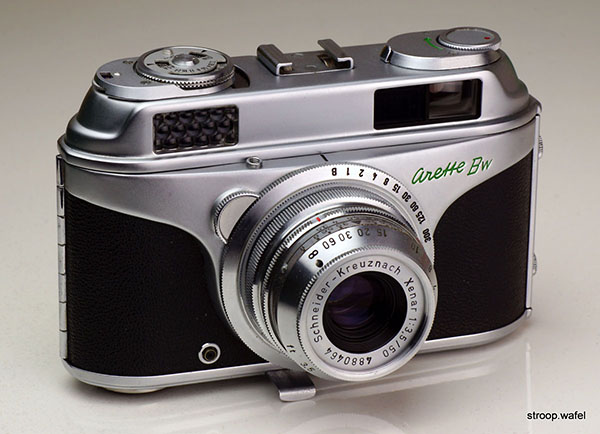
An Arette Bw with interchangeable Schneider Xenar 50mm f/2.8.
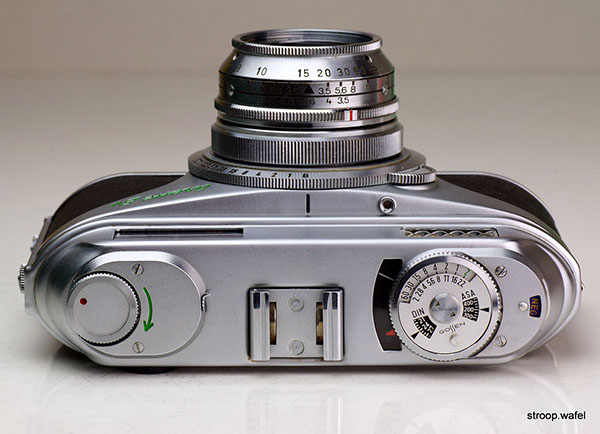
Top view of an Arette Bw showing the traditional style Gossen light meter with shutter speed and aperture values, not LV values settings.
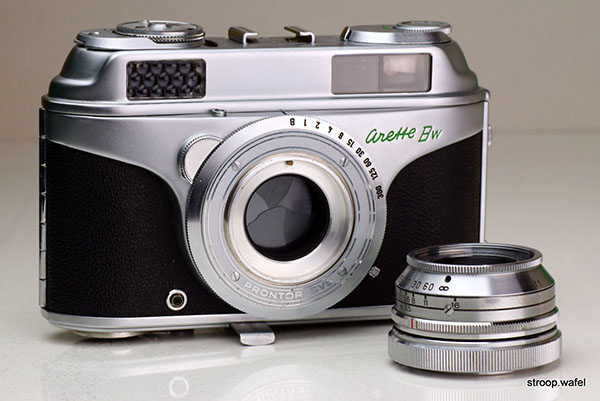
Arette Bw with lens detached. The lens is secured to the mount with a threaded collar which screws to the camera body.
The Arette range was around 1959 updated with larger and brighter viewfinders. It has therefore been necessary to enlarge the top housings, but this did somehow make the cameras lose some of their aesthetic appeal. The Arette Bw and BN above were thus updated, with the lightmeter on the BN rather awkwardly mounted in the middle of the top housing, and new versions were also produced of the Arette A (sold in the UK as Arette P and Arette Super P) with increasingly large viewfinders. In addition, new models were introduced, such as the Automatic S (coupled light meter) and SE/SR (coupled light meter and coupled rangefinder), as well as the Arette W (viewfinder model with interchangeable lens mount). See further below for several of these.
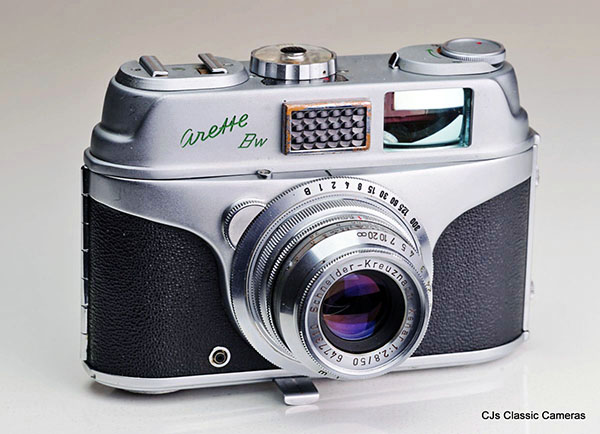
Second version of the Arette Bw with larger viewfinder, here with interchangeable Schneider Xenar lens. Although this viewfinder was definitively an improvement, I am less impressed by the lightmeter cell, which looked like an unfortunate afterthought.
Arette Automatic S
The Arette Automatic-S introduced a new feature to the Arette range, namely an automatic exposure mode, where the camera would decide the shutter speed for a preselected aperture setting. In addiation, the lightmeter needle was projected in the viewfinder, so one could get the right exposure without taking ones eye of the viewfinder. This Arette was part of the redesigned range of Arettes with a larger viewfinder window and therefore a larger top housing, as already discussed above under the Arette Bw. On this model this new design does not bother me as much. There was also a rangefinder version of this model, the Automatic SE or SR (export version).
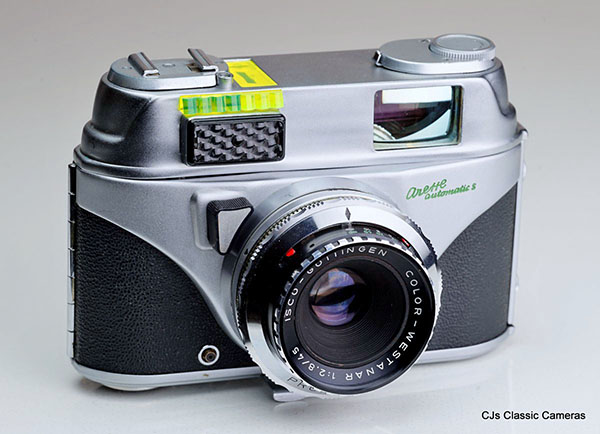
An Automatic S with Isco Color-Westanar lens 45mm f/2.8 lens. Note the small red tabs on the side of the lens, which indicated the depth of field and moved automatically when adjusting the aperture.
Arette W
The Arette W had an interchangeable lens mount but was a viewfinder only camera, and thus a simplified version of the Arette Bw. It does not have an earlier equivalent.
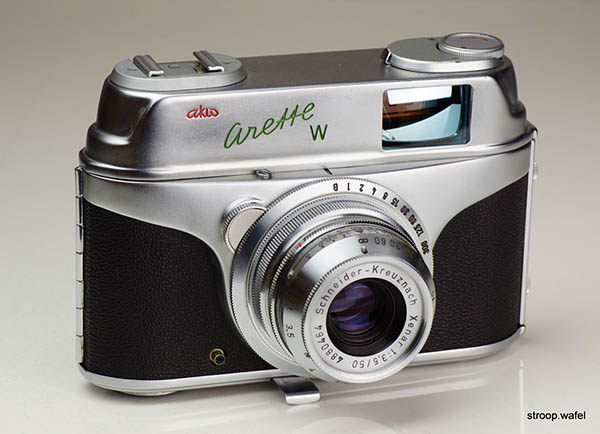
An Arette W with interchangeable Schneider Xenar 50mm f/3.5 lens.
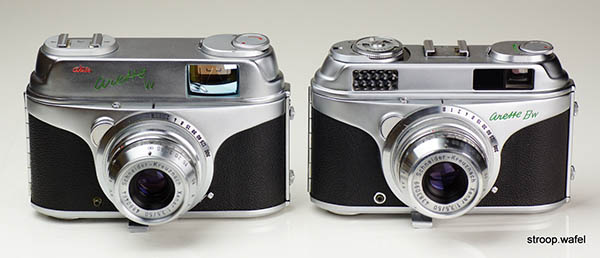
Arette W and Arette BW side by side. Only the top housing was changed in the new generation of Arette cameras, but it changed the appearance of the cameras from sleek to rather clumsy looking.
Arette Super P
As mentioned above, the Arette A was the redesigned version of the Arette IA with larger brightframe viewfinder. Two versions with different size viewfinders existed, probably later production having the largest. It was marketed in the U.K. as the Arette P and Arette Super-P, the latter being the version with larger viewfinder. Whereas both versions of the the Arette A were available with a choice of shutters (Vario, Pronto, Prontor-SVS), the Arette P and Super-P appear to have been available exclusively with Vario and Prontor-SVS shutters, respectively. The Arette A was also rebadged as the Arette Favorit, which appears to have been marketed in Scandinavia only.
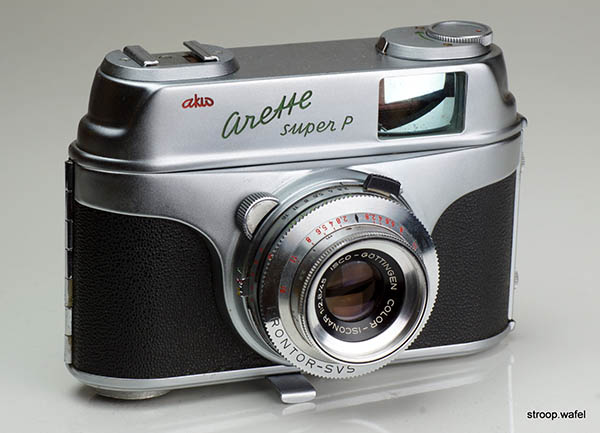
An Arette Super-P with ISCO Color-Isconar 45mm f/2.8 lens in Prontor-SVS shutter.
In 1960 akw, as the company was now called, revived the name Akarelle for a range of cheapish cameras with redesigned bodies similar to equivalent lines of King and Agfa cameras. Gone were the sleek lines that made the Arette range so iconic and recognisable. Perhaps akw tried to revive some of its old fortunes by reviving the name it had mothballed about five years earlier. Whatever the reasons, it was not a strategy that worked and the company became soon insolvent. The new Akarelle line-up was similar to the earlier Arette range, the Akarelle W, Bw and Automatic S and SE being the new equivalents of the similarly named earlier Arettes, respectively, whereas it appears that the Akarelle V and P where equivalent to the Arette A but with Vario and Pronto shutter, respectively.
Akarelle Bw
One example of the new Akarelle line was the Akarelle Bw with interchangeable lens mount. It had an uncoupled lightmeter, the selenium cell of which was stuck rather akwardly in the centre of the top housing. Other than the interchangeable lens mount, the Akarelle Bw was functionally still a very similar camera as the Arette I-B from four years earlier. It was this lack of innovation at a time when other manufacturers introduced increasingly advanced cameras that probably signalled the end of the company.
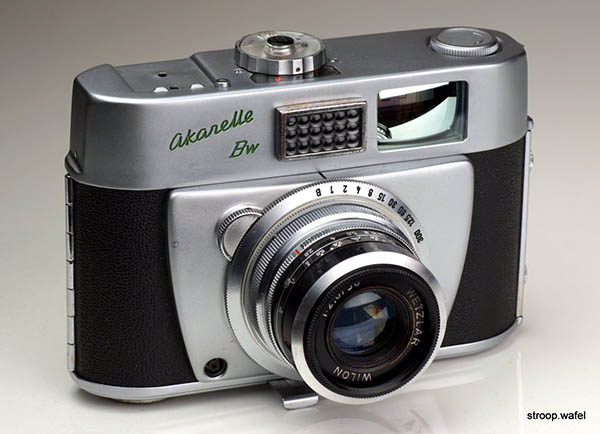
Akarelle Bw with interchangeable Wetzlar Wilon 50/2.8 lens. The accessory shoe has come off this one and exposes the thin bit of metal top housing it was attached to, testifying to the flimsy built of this range.
Akarelle V
Another member of the new Akarelle line was the Akarelle V, a simple camera with brightframe viewfinder. It came with a Vario shutter, with only three shutter speeds and no selftimer, and I suspect that's what the 'V' in the name stood for. There was a very similar model called the Akarelle P, which had a Pronto shutter instead.
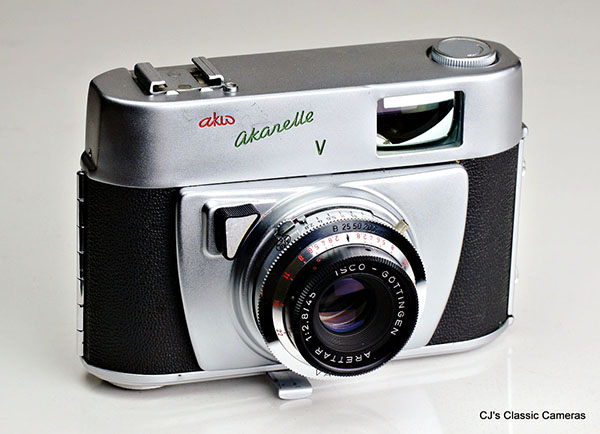
Akarelle V with Arettar 45/2.8 lens in Vario shutter. On this model the triangular plastic shutter release button appeared.
Akarelle Automatic SE
Despite my reservations about the new Akarelle line indicated above, I do sort of like the Automatic SE. It was the most advanced of the lot, having a coupled rangefinder (admittedly with a very short base) as well as a coupled lightmeter, the needle of which was projected in the viewfinder. The camera's styling was still no comparison to the earlier Arettes, but it looked more balanced and better finished than most of the other new Akarelles. Unfortunately, it came a little too late. Many German camera companies were struggling and akw was no exception. Around 1960 camera production stopped.
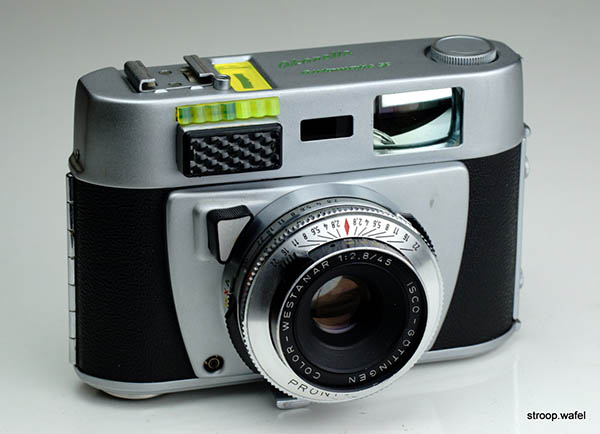
Akarelle Automatic SE with ISCO Color-Westanar 45mm f/2.8 lens in Prontor-SLK shutter. The strikingly fluorescent yellow plastic parts made up the lightmeter window. The needle was also projected in the viewfinder.
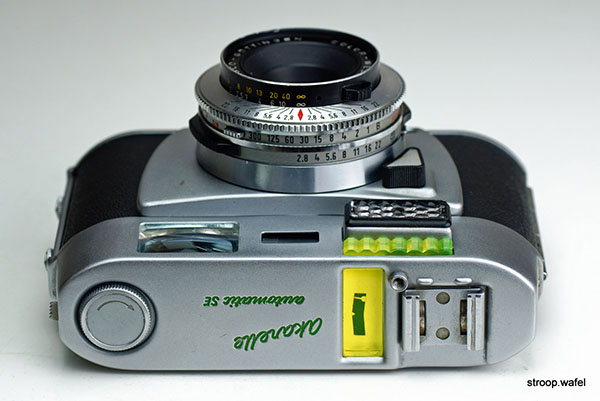
Top view of Akarelle Automatic SE showing the coupled lightmeter more clearly.
Akw Reichert microscope camera
Many camera makers made technical cameras to be used with scientific equipment. I wasn't aware that Akw made some too, until I recently came across the camera shown below. It is branded 'Reichert Austria', a microscope manufacturer, but it was clearly maded by Akw. Typical features are the top and bottom plates as well as focussing tabs and rewind knob, which are similar to those found on the Arette IA. Interestingly, the serial number of this particular example is in the range of much later new Akarelle models. Originally it would have come with an adapter to fit it onto a microscope, which would have included a shutter.
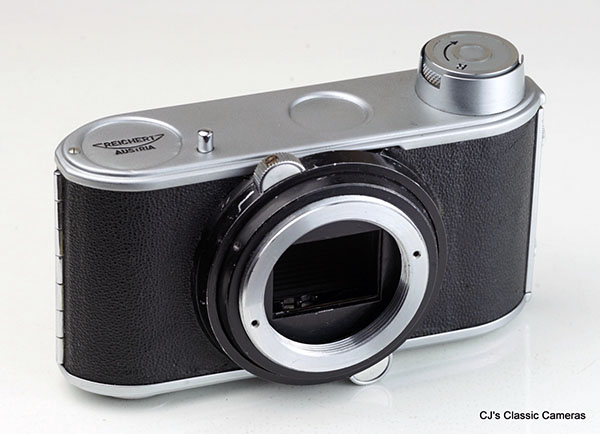
The camera had no shutter, and what looks like focussing tabs are actually tabs on a ring which opens and closes a light gate.
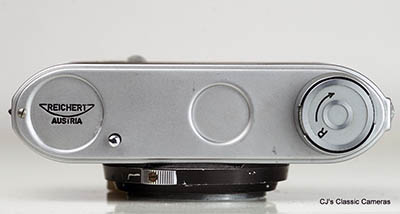 |
Top view of the Reichert microscope camera.
|
| 
